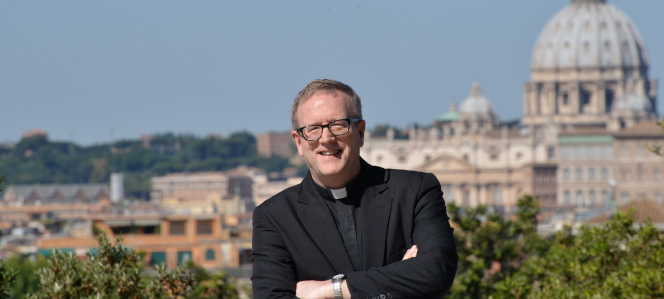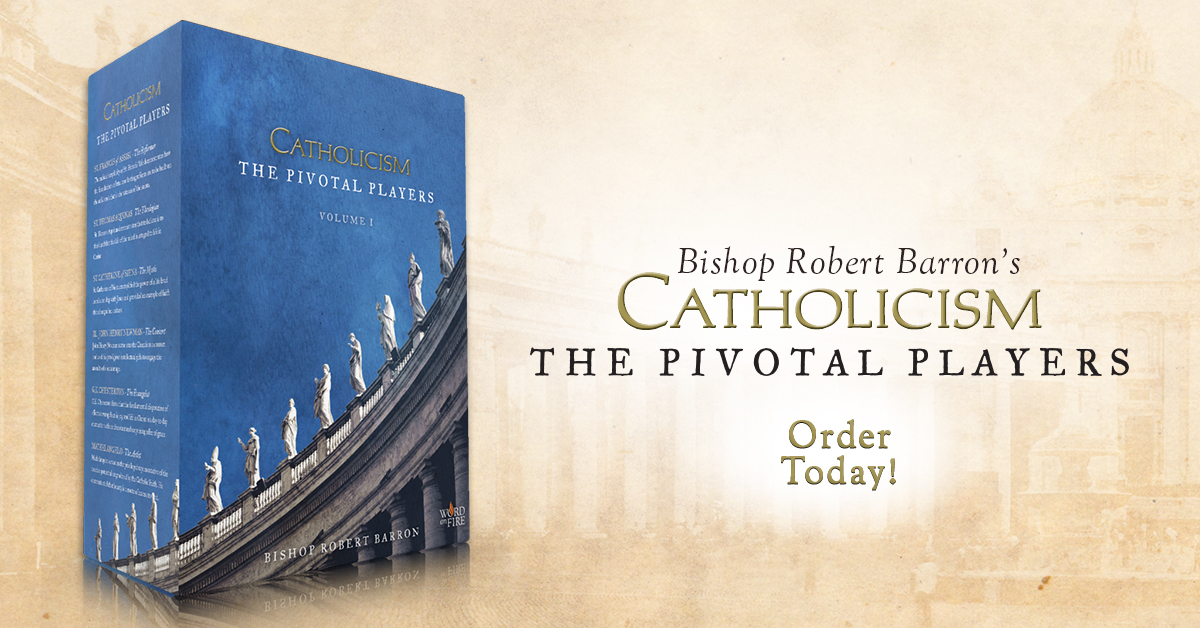Today marks the official release of Bishop Robert Barron’s new film series, CATHOLICISM: The Pivotal Players. Years in the making, this multi-part film series illumines a handful of saints, artists, mystics, and scholars who not only shaped the life of the Church but changed the course of civilization.
Volume I of the series features the following Pivotal Players:
- St. Francis of Assisi
- St. Thomas Aquinas
- St. Catherine of Siena
- Bl. John Henry Newman
- G.K. Chesterton
- Michelangelo
On this special day, we sit down with Bishop Barron to discuss his new series, look at each of the pivotal players, and learn about what’s next for his production team. Enjoy!
QUESTION: Your CATHOLICISM series debuted in 2011 and was a success by any standard. It was seen by millions on PBS and EWTN and it has been a go to resource for catechesis and evangelization in thousands of parishes, dioceses and schools. Why do you think the CATHOLICISMseries resonated with so many people?
BISHOP BARRON: I think that it proved to be compelling to so many because my approach, to lead with the beautiful and through that elucidate what is good and true, resonated with lots of people. Folks have a tendency to put up defenses when confronted by truth claims or moral imperatives, but these defenses are likely to come down when they witness something that is so beautiful that it literally takes their breath away. There is much beauty in the Catholic Faith and I endeavored in the CATHOLICISM series to offer the aesthetic of the Church as the first route of access into understanding what Catholics believe and why.
I would also cite a second reason the CATHOLICISM series proved to be so compelling: it placed a priority on the Church as a bearer of the mystery and revelation of Jesus Christ, first and foremost. Too much of the Church’s self-presentation takes for granted that people know the divine person of Jesus. Therefore Christ becomes implicit, rather than explicit, and this can easily become problematic. I endeavored to give Jesus Christ a priority in the CATHOLICISM series and impress upon the viewer that the Church is the extension of the Incarnation of God across space and time.
QUESTION: How did CATHOLICISM: The Pivotal Players come about? Why did you decide this time to approach the faith by highlighting the lives and contributions of artists, mystics, saints and scholars?
BISHOP BARRON: The original CATHOLICISM series is actually a popularization of the theological and Christological themes I explore in a book I wrote entitled The Priority of Christ. In that book I explored the startling revelation of God’s revelation in Christ, a revelation that continues in the Church and that takes particular forms in the lives the holy men and women that the Church calls the saints. It seemed to be an important next step for the CATHOLICISM documentary to continue with the lives of those men and women whose impact on the Church and civilization was so profound that they can best be described as pivotal players. Not all the pivotal players are formally canonized saints, but all manifest the power of Jesus Christ, working through men and women to effect the transformation of the world.
QUESTION: You travelled extensively for this new series. What were some memorable sites and experiences?
BISHOP BARRON: I think especially of the sites associated with St. Thomas Aquinas, who has had such a deep impact on my life, and those of Blessed John Henry Newman. Also, the pilgrimage to the sites associated with St. Catherine of Siena and St. Francis provided an opportunity to encounter them as if for the first time, and praying at the grave of G.K. Chesterton was profoundly moving.
Remarkably, we were given privileged access to Michelangelo’s great masterpieces, particularly the Sistine Chapel, the Pauline Chapel, the Pieta, and the David. Being in the presence of Michelangelo’s artistic legacy was the experience of a lifetime.
QUESTION: St. Francis is a popular and beloved saint who even appeals to non-Christians. Though he is Catholic, many Protestants and atheists revere him, too. How do you explain this attraction?
BISHOP BARRON: I think people experience in St. Francis a disciple of Jesus whose love for Christ was such that it made him an image of the Savior. The appeal of St. Francis is his likeness to Jesus Christ. I also think that he manifests the pathos and glory of Christian witness in the world, not in the abstract, but in real flesh and blood.
QUESTION: Most people know St. Thomas Aquinas for his sublime intellect, yet you also identify him as a spiritual master. How does his sanctity illuminate his intellectual gifts?
BISHOP BARRON: Aquinas’ sanctity elevated his intellectual gifts beyond the limits that mere nature imposes. His theological insights, so rich, profound, and deep, are evidence of the intensity of his relationship with Jesus Christ as a living, divine person who desires us to know him as one knows a friend.
QUESTION: St. Catherine of Siena was a mystic and wonderworker, yet she remains accessible and approachable. What lessons do her life and teachings offer to the faithful today?
BISHOP BARRON: St. Catherine demonstrates that love for Christ by necessity entails love for the Church, even when, and especially when, the faithful who constitute Christ’s Mystical Body on earth are resistant or seemingly unworthy of our love.
QUESTION: Blessed John Henry Newman is identified as “the convert” in the series. What is important to know about his conversion and why is his conversion so pivotal for the Church?
BISHOP BARRON: Blessed John Henry Newman’s conversion was unexpected, as the summons to discipleship so often is, and that summons compelled a decision. The decision led necessarily to sacrifice, even suffering, but despite the conditions the Lord imposed, John Henry Newman accepted.
Too often Christian discipleship becomes a caricature. We dabble in it, choosing this or that aspect rather than giving our full assent, believing that blessing is a matter of prosperity rather than the opportunity to love and to serve.
Newman shows forth in his life the spiritual power that is unleashed when one gives assent to what Jesus wants, and what happens when we allow him to lead us onto paths unexpected and unknown.
QUESTION: Why is GK Chesterton a powerful antidote for our disenchanted, secular culture? What lessons does he offer “new evangelists” today?
BISHOP BARRON: Secularism is a kind of simulacrum of Christianity without Christ and the Church. It is Christ-haunted and its refusal of Christ makes it lack a soul.
Chesterton reminds secularity who we really are and that it is the strange witness of God become man in Christ and the enduring presence of the Church that gives secularism what it lacks, and truly needs, namely a soul. A culture with a truly Christian soul is imbued with joy and this is the lesson Chesterton imparts to “new evangelists”. Those who are the friends of Christ are a people of mirth, of joy, and it is through their joy, that they manifest Christ’s power to redeem and save and show that the unique Christian way of life is truly worth living.
The Church is not a threat to human flourishing, but the great advocate of humanity made fully alive!
QUESTION: Michelangelo illuminated the reality of God through his artistic genius. Why is art an important route of access to God? How does Michelangelo evangelize through his work?
BISHOP BARRON: Art is a participation in the transcendental of the beautiful, an attribute of God, and beautiful art can be a route of access to God. Michelangelo represents the artist as evangelist par excellence, for he understood his artistic genius as a gift that was intended, not just to manifest the potential of human creativity, but to facilitate an encounter with God.
QUESTION: You’ve hinted that there will be a Volume II of CATHOLICISM: The Pivotal Players. Who will be featured in it and why?
BISHOP BARRON: Yes! I’ve already completed four new film scripts on St. Augustine, St. Benedict, St. Ignatius, and Bartolomé de las Casas. My Word on Fire team is moving forward with the production of these new episodes. I still have script on St. Ireneaus that I am working on, and there may be another pivotal player after that (but that is a secret).
QUESTION: A secret?
BISHOP BARRON: It really depends on my schedule as bishop. But I’m hoping we can includes sixth pivotal player in Volume II!
QUESTION: Can you give us a hint who that may be?
BISHOP BARRON: Well, without giving too much away, I am thinking about an American woman. That’s all I will say right now. Again, it will really depend on a whether there will be time and resources to continue the series.

